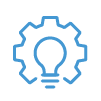
Last updated December 19, 2024
Introduction
Entrepreneurs may be reluctant to embrace AI because they trust human actions more than the unknown and mysterious actions of AI. However, this may mean they miss opportunities to save time and money or benefit from innovative and creative solutions. They may be suffering from the ambiguity effect. In this article, we talk about what it means, how it arises and how you can take it into account as an entrepreneur.
What is the ambiguity effect?
The ambiguity effect describes our preference for options that we know, as opposed to options that we feel lack information or are debatable (Ellsberg, 1961).
We would rather be well informed than leave too much to the imagination. Because of the ambiguity effect, we don't give two equal options equal chances. You don't give the unknown a chance because you think the risk is too great. This can make for a suboptimal decision, which also prevents you from taking advantage of any long-term benefits of the riskier choice.
The ambiguity effect is similar to risk aversion, only in the ambiguity effect the voter has even less information available. In the ambiguity effect, the voter knows the likely outcome of only one of the options; in risk aversion, he knows about both and chooses the one with the highest probability of success. With both, we do not like to gamble on an option that is risky. Do you dare to choose something unknown? Are you satisfied with lesser success? Do you dare to take risks?
How does the ambiguity effect arise?
We don't like uncertainty. Therefore, we will try to avoid that feeling of uncertainty and choose an option whose outcome we are almost certain of. Especially when we need to make a decision quickly. However, you can never know everything about a subject. Focusing your attention too much on how much you don't know can make the uncertain option seem even more uncertain. And do you actually know enough about the more certain option (Frisch & Baron, 1988)?
Among men, the ambiguity effect is more pronounced than among women. However, this difference becomes smaller when the difference in ignorance between one option and the other is greater (Borghans, Golsteyn, Heckman & Meijers, 2009).

Examples in practice
- Choice of hotels: you are going on a business trip and are hesitating between two different hotels. One hotel has a pretty good rating, the other hotel is just new and has not yet received any reviews. You choose the hotel with the average rating, rather than the uncertainty of the other hotel, even though it could be a great hotel.
- Trying out new marketing channels: Ikea only launched its webshop in the Netherlands in 2013 and it still exudes that they don't want to focus too much on it. Products are often not available or the delivery time is very long. This while plenty of furniture and interior items are sold online.
- Remote working: many companies were initially reluctant to move to remote working or flexible working hours, despite the benefits to employee productivity and satisfaction and the savings in office space. The corona pandemic ensured that they did have to, which went surprisingly well.
Using the ambiguity effect to your advantage
As a business owner, you must realize that a potential customer is looking for security. If you can offer him that, he/she is more likely to choose you.
- Offer trial periods orfree trial versions: Uncertainty about new products or services can make customers reluctant. Offering trial periods or free trial versions allows customers to try the product or service first without risk. This reduces unfamiliarity and helps them experience how valuable the product can be, making them more likely to proceed with a purchase.
- Share customer stories and collect reviews: Use testimonials, customer stories and case studies to demonstrate the success of your products or services. When potential customers see how others have benefited in similar situations, uncertainty is reduced. This makes it easier for them to trust your offerings because they have concrete examples of positive results.
- Provide clear information and support: Make sure you offer comprehensive and clear information about your products or services. You can do this through detailed product descriptions, instructional videos, and extensive FAQ sections. In addition, you can provide excellent customer service, such as live chat support, to answer any questions or concerns immediately. By providing potential customers with all the information they need, you reduce uncertainty and increase their confidence to make a purchase.
Resources
Borghans, L, Golsteyn, B.H.H., Heckman, J.J., & Meijers, H. (2009). "Gender differences in risk aversion and ambiguity aversion." Journal of the European Economic Association. 7(2-3), 649-658.
Ellsberg, D. (1961). "Risk, ambiguity, and the savage axioms." The Quarterly Journal of Economics. 75(4), 643-669.
Frisch, D., & Baron, J. (1988). "Ambiguity and rationality." Journal of Behavioral Decision Making, 1(3), 149-157.
Are the results from your online marketing disappointing?
Request our no-obligation performance scan and we'll tell you where you're going wrong.

















 Team
Team FAQ
FAQ Vacancies
Vacancies Contac
Contac AWR
AWR Ahrefs
Ahrefs Channable
Channable ContentKing
ContentKing Leadinfo
Leadinfo Optmyzr
Optmyzr Qooqie
Qooqie Hubspo
Hubspo Semrush
Semrush




